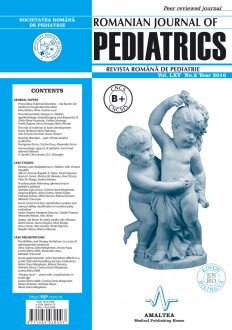SELECT ISSUE

Indexed

| |

|
|
|
| |
|
|
|

|
|
|
|
|
|
|
HIGHLIGHTS
National Awards “Science and Research”
NEW! RJP has announced the annually National Award for "Science and Research" for the best scientific articles published throughout the year in the official journal.
Read the Recommendations for the Conduct, Reporting, Editing, and Publication of Scholarly work in Medical Journals.
The published medical research literature is a global public good. Medical journal editors have a social responsibility to promote global health by publishing, whenever possible, research that furthers health worldwide.
TROMBOCYTOSIS FOLLOWING SPLENECTOMY IN PEDIATRIC PATIENTS
Alina Grama, Andreea Durlan, Andreea Ligia Dinca, Cristina Oana Mărginean, Horea Gozar, Maria Despina Baghiu, Mihaela Chincesan, Mihai Stanca and Raluca Damian
ABSTRACT
Thrombocytosis represents a platelet count over 500.000/mm³.
Objective. The aim of this study is to evaluate the frequency and gravity of reactive thrombocytosis in pediatric patients who underwent splenectomy.
Material and method. We performed a retrospective study including 20 patients (4-16 years old) who underwent splenectomy between 2006-2015. The inclusion criteria in the study were: patients with the age under 18 years, who underwent splenectomy independently by the cause, and who developed afterwards thrombocytosis.
Results. In the studied group 64% of the splenectomised patients (16) developed a form of thrombocytosis. In 4 cases – severe form (Platelets > 1 million/mm3) and in 7 cases a mild form. There were not noticed any significant differences regarding the gender repartition of the patients (9 were females, and 11 were males). In 13 patients, thrombocytosis disappeared after 30 days, and only in 3 cases, the episode lasted more than 360 days. Thrombotic phenomena were noticed only in one patient from our study group. All the patients benefited from thromboprophylaxis and hydration measures, and 2 cases needed associated treatment with Hydroxyurea.
Conclusions. Our study reveals an increased frequency of thrombocytosis after splenectomy (80%), with a maximum peak of incidence in 2-10 days following the intervention, thrombocytosis being generally benign and self-limited; still one of the cases experienced thrombotic complications and severe thrombocytosis was more frequent after post-traumatic splenectomy.
Keywords: thrombocytosis, splenectomy, child
